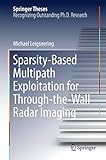Sparsity-Based Multipath Exploitation for Through-the-Wall Radar Imaging [electronic resource] / by Michael Leigsnering.
By: Leigsnering, Michael [author.] .
.
Contributor(s): SpringerLink (Online service) .
.
Material type:  BookSeries: Springer Theses, Recognizing Outstanding Ph.D. Research: Publisher: Cham : Springer International Publishing : Imprint: Springer, 2018Edition: 1st ed. 2018.Description: XX, 108 p. 38 illus., 21 illus. in color. online resource.Content type: text Media type: computer Carrier type: online resourceISBN: 9783319742830.Subject(s): Signal processing
BookSeries: Springer Theses, Recognizing Outstanding Ph.D. Research: Publisher: Cham : Springer International Publishing : Imprint: Springer, 2018Edition: 1st ed. 2018.Description: XX, 108 p. 38 illus., 21 illus. in color. online resource.Content type: text Media type: computer Carrier type: online resourceISBN: 9783319742830.Subject(s): Signal processingThis thesis reports on sparsity-based multipath exploitation methods for through-the-wall radar imaging. Multipath creates ambiguities in the measurements provoking unwanted ghost targets in the image. This book describes sparse reconstruction methods that are not only suppressing the ghost targets, but using multipath to one’s advantage. With adopting the compressive sensing principle, fewer measurements are required for image reconstruction as compared to conventional techniques. The book describes the development of a comprehensive signal model and some associated reconstruction methods that can deal with many relevant scenarios, such as clutter from building structures, secondary reflections from interior walls, as well as stationary and moving targets, in urban radar imaging. The described methods are evaluated here using simulated as well as measured data from semi-controlled laboratory experiments.


There are no comments for this item.